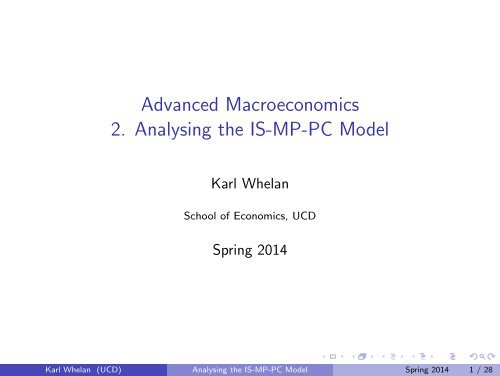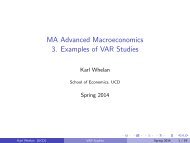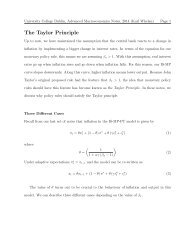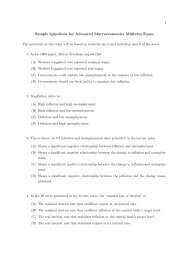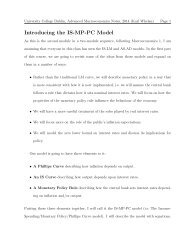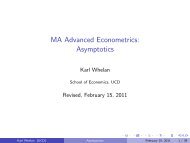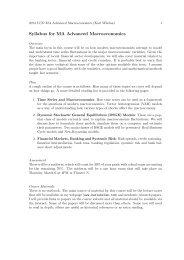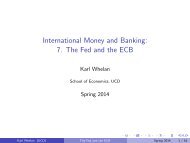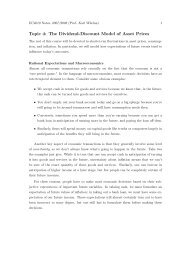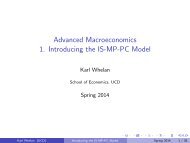Macroeconomics 2: Analysing the IS-MP-PC Model - Karl Whelan
Macroeconomics 2: Analysing the IS-MP-PC Model - Karl Whelan
Macroeconomics 2: Analysing the IS-MP-PC Model - Karl Whelan
- No tags were found...
Create successful ePaper yourself
Turn your PDF publications into a flip-book with our unique Google optimized e-Paper software.
Advanced <strong>Macroeconomics</strong><br />
2. <strong>Analysing</strong> <strong>the</strong> <strong>IS</strong>-<strong>MP</strong>-<strong>PC</strong> <strong>Model</strong><br />
<strong>Karl</strong> <strong>Whelan</strong><br />
School of Economics, UCD<br />
Spring 2014<br />
<strong>Karl</strong> <strong>Whelan</strong> (UCD) <strong>Analysing</strong> <strong>the</strong> <strong>IS</strong>-<strong>MP</strong>-<strong>PC</strong> <strong>Model</strong> Spring 2014 1 / 28
Part I<br />
Inflation Expectations<br />
<strong>Karl</strong> <strong>Whelan</strong> (UCD) <strong>Analysing</strong> <strong>the</strong> <strong>IS</strong>-<strong>MP</strong>-<strong>PC</strong> <strong>Model</strong> Spring 2014 2 / 28
Changes in Inflation Expectations<br />
Last time we considered <strong>the</strong> simplest possible example: ɛ π t = ɛ y t = 0 and<br />
πt e = π ∗<br />
This means no “shocks” and <strong>the</strong> public’s expectation of inflation equals <strong>the</strong><br />
central bank’s inflation target, π ∗ = π 1 .<br />
This generates an outcome where π t = π 1 and y t = y ∗ t .<br />
Now consider a case where inflation expectations shift to being higher than<br />
<strong>the</strong> central bank’s target rate.<br />
In this case, π e t = ¯π > π 1 = π ∗ :<br />
After <strong>the</strong> increase in inflation expectations:<br />
◮ The <strong>PC</strong> curve shifts upwards.<br />
◮ Output ends up being lower than its natural rate<br />
◮ Inflation rises. It ends up taking a value between πt e and π ∗ .<br />
<strong>Karl</strong> <strong>Whelan</strong> (UCD) <strong>Analysing</strong> <strong>the</strong> <strong>IS</strong>-<strong>MP</strong>-<strong>PC</strong> <strong>Model</strong> Spring 2014 3 / 28
Expected Inflation Equals <strong>the</strong> Inflation Target<br />
Inflation<br />
<strong>IS</strong>-<strong>MP</strong> (<br />
<strong>PC</strong> ( )<br />
Output<br />
<strong>Karl</strong> <strong>Whelan</strong> (UCD) <strong>Analysing</strong> <strong>the</strong> <strong>IS</strong>-<strong>MP</strong>-<strong>PC</strong> <strong>Model</strong> Spring 2014 4 / 28
Expected Inflation Exceeds <strong>the</strong> Inflation Target<br />
Inflation<br />
<strong>IS</strong>-<strong>MP</strong> (<br />
<strong>PC</strong> (<br />
)<br />
̅<br />
̅<br />
<strong>PC</strong> ( )<br />
Output<br />
<strong>Karl</strong> <strong>Whelan</strong> (UCD) <strong>Analysing</strong> <strong>the</strong> <strong>IS</strong>-<strong>MP</strong>-<strong>PC</strong> <strong>Model</strong> Spring 2014 5 / 28
Can We Learn More<br />
The outcome here shows that inflation ends up between <strong>the</strong> public’s inflation<br />
expectations and <strong>the</strong> central bank’s inflation target.<br />
What determines this outcome What determines how far from away target<br />
inflation will move when <strong>the</strong> public’s inflation expectations change<br />
◮<br />
◮<br />
How much does it depend on <strong>the</strong> monetary policy rule<br />
How much does it depend on o<strong>the</strong>r aspects of <strong>the</strong> model, like <strong>the</strong> impact<br />
of real interest rates on output and <strong>the</strong> impact of output on inflation<br />
It would be tricky to get <strong>the</strong>se answers from a graph.<br />
However, using <strong>the</strong> equations underlying <strong>the</strong> model, we can fully answer all<br />
<strong>the</strong>se questions.<br />
<strong>Karl</strong> <strong>Whelan</strong> (UCD) <strong>Analysing</strong> <strong>the</strong> <strong>IS</strong>-<strong>MP</strong>-<strong>PC</strong> <strong>Model</strong> Spring 2014 6 / 28
Getting a Solution for <strong>the</strong> <strong>IS</strong>-<strong>MP</strong>-<strong>PC</strong> <strong>Model</strong><br />
Let’s repeat <strong>the</strong> equations describing our two curves.<br />
The <strong>PC</strong> curve is<br />
π t = πt e + γ (y t − yt ∗ ) + ɛ π t<br />
And <strong>the</strong> <strong>IS</strong>-<strong>MP</strong> curve is<br />
y t = y ∗ t − α (β π − 1) (π t − π ∗ ) + ɛ y t<br />
Taking all <strong>the</strong> o<strong>the</strong>r elements of <strong>the</strong> model as given, we can view this as two<br />
linear equations in <strong>the</strong> two variables π t and y t .<br />
These equations can be solved to give solutions that describe how <strong>the</strong>se two<br />
variables depend on all <strong>the</strong> o<strong>the</strong>r elements of <strong>the</strong> model.<br />
<strong>Karl</strong> <strong>Whelan</strong> (UCD) <strong>Analysing</strong> <strong>the</strong> <strong>IS</strong>-<strong>MP</strong>-<strong>PC</strong> <strong>Model</strong> Spring 2014 7 / 28
The <strong>IS</strong>-<strong>MP</strong>-<strong>PC</strong> <strong>Model</strong> Solution for Inflation<br />
The <strong>PC</strong> curve is<br />
π t = π e t + γ (y t − y ∗ t ) + ɛ π t<br />
And <strong>the</strong> <strong>IS</strong>-<strong>MP</strong> curve tells us that<br />
y t − y ∗ t<br />
= −α (β π − 1) (π t − π ∗ ) + ɛ y t<br />
Substituting this expression for <strong>the</strong> output gap into <strong>the</strong> Phillips curve and<br />
re-arranging we get<br />
(<br />
) ( )<br />
1<br />
αγ<br />
π t =<br />
π e (βπ − 1)<br />
t +<br />
π ∗ γɛ y t + ɛ π t<br />
+<br />
1 + αγ (β π − 1) 1 + αγ (β π − 1) 1 + αγ (β π − 1)<br />
Letting<br />
We get<br />
θ =<br />
1<br />
1 + αγ (β π − 1)<br />
π t = θπ e t + (1 − θ) π ∗ + θ (γɛ y t + ɛ π t )<br />
<strong>Karl</strong> <strong>Whelan</strong> (UCD) <strong>Analysing</strong> <strong>the</strong> <strong>IS</strong>-<strong>MP</strong>-<strong>PC</strong> <strong>Model</strong> Spring 2014 8 / 28
Interpreting <strong>the</strong> Solution for Inflation<br />
What’s <strong>the</strong> meaning of our solution<br />
π t = θπ e t + (1 − θ) π ∗ + θ (γɛ y t + ɛ π t )<br />
If β π > 1 as we’ve been assuming, <strong>the</strong>n 0 < θ < 1. This means that inflation<br />
lies between <strong>the</strong> central bank’s inflation target and <strong>the</strong> public’s expectation of<br />
inflation.<br />
We can show that θ depends negatively on α, γ and β π . This means that <strong>the</strong><br />
central bank’s inflation target plays more role in determining inflation when<br />
1 γ increases: This parameter determines how inflation changes when<br />
output changes.<br />
2 α increases: This parameter determines how output changes when real<br />
interest rates change.<br />
3 β π increases: This parameter determines how <strong>the</strong> central bank responds<br />
to inflation.<br />
<strong>Karl</strong> <strong>Whelan</strong> (UCD) <strong>Analysing</strong> <strong>the</strong> <strong>IS</strong>-<strong>MP</strong>-<strong>PC</strong> <strong>Model</strong> Spring 2014 9 / 28
The <strong>IS</strong>-<strong>MP</strong>-<strong>PC</strong> <strong>Model</strong> Solution for Output<br />
The <strong>IS</strong>-<strong>MP</strong> curve tells us that output depends on how far inflation is from <strong>the</strong><br />
central bank’s target<br />
y t − y ∗ t<br />
= −α (β π − 1) (π t − π ∗ ) + ɛ y t<br />
Re-arranging <strong>the</strong> solution for inflation, we get<br />
This gives<br />
which can be simplified to<br />
π t − π ∗ = θ (π e t − π ∗ + ɛ π t + γɛ y t )<br />
y t = y ∗ t − θα (β π − 1) (π e t − π ∗ + ɛ π t + γɛ y t ) + ɛ y t<br />
y t = y ∗ t − θα (β π − 1) (π e t − π ∗ + ɛ π t ) + (1 − θαγ (β π − 1)) ɛ y t<br />
Output falls short of its natural rate if inflation expectations exceed <strong>the</strong><br />
inflation target. And <strong>the</strong> amount of <strong>the</strong> shortfall depends positively on <strong>the</strong><br />
three factors mentioned before: α, γ and β π .<br />
<strong>Karl</strong> <strong>Whelan</strong> (UCD) <strong>Analysing</strong> <strong>the</strong> <strong>IS</strong>-<strong>MP</strong>-<strong>PC</strong> <strong>Model</strong> Spring 2014 10 / 28
How Do Inflation Expectations Change<br />
We have seen that after <strong>the</strong> public’s inflation expectations rise, <strong>the</strong> result is a<br />
fall in output below its natural rate and in increase inflation, though this<br />
increase is smaller than had been expected by <strong>the</strong> public.<br />
What happens next How does <strong>the</strong> public’s expectation of inflation change at<br />
this point<br />
Milton Friedman’s 1968 paper suggested that people gradually adapt <strong>the</strong>ir<br />
expectations based on past outcomes for inflation.<br />
Consider now a simple model of this idea of “adaptive expectations”<br />
π e t = π t−1<br />
Under this formulation of expectations, <strong>the</strong> Phillips curve becomes<br />
π t = π t−1 + γ (y t − y ∗ t ) + ɛ π t<br />
In o<strong>the</strong>r words, <strong>the</strong>re should be a positive relationship between <strong>the</strong> change in<br />
inflation and <strong>the</strong> output gap. Alternatively, <strong>the</strong>re should be a negative<br />
relationship between <strong>the</strong> change in inflation and <strong>the</strong> rate of unemployment.<br />
<strong>Karl</strong> <strong>Whelan</strong> (UCD) <strong>Analysing</strong> <strong>the</strong> <strong>IS</strong>-<strong>MP</strong>-<strong>PC</strong> <strong>Model</strong> Spring 2014 11 / 28
The Failure of <strong>the</strong> Phillips Curve<br />
11<br />
US Inflation and Unemployment, 1955-2013<br />
Inflation is <strong>the</strong> Four-Quarter Percentage Change in GDP Deflator<br />
10<br />
9<br />
Unemployment<br />
8<br />
7<br />
6<br />
5<br />
4<br />
3<br />
0 2 4 6 8 10 12<br />
Inflation<br />
<strong>Karl</strong> <strong>Whelan</strong> (UCD) <strong>Analysing</strong> <strong>the</strong> <strong>IS</strong>-<strong>MP</strong>-<strong>PC</strong> <strong>Model</strong> Spring 2014 12 / 28
Evidence for Adaptive Inflation Expectations<br />
11<br />
Changes in US Inflation and Unemployment, 1955-2013<br />
Change in Inflation is Four-Quarter Inflation Relative to a Year Earlier<br />
10<br />
9<br />
8<br />
Unemployment<br />
7<br />
6<br />
5<br />
4<br />
3<br />
2<br />
-7.5 -5.0 -2.5 0.0 2.5 5.0 7.5 10.0<br />
Change in Inflation<br />
<strong>Karl</strong> <strong>Whelan</strong> (UCD) <strong>Analysing</strong> <strong>the</strong> <strong>IS</strong>-<strong>MP</strong>-<strong>PC</strong> <strong>Model</strong> Spring 2014 13 / 28
Inflation Expectations Adjusting Back Downwards<br />
Inflation<br />
<strong>IS</strong>-<strong>MP</strong> (<br />
<strong>PC</strong> ( ̅<br />
)<br />
<strong>PC</strong> ( )<br />
̅<br />
<strong>PC</strong> ( )<br />
Output<br />
<strong>Karl</strong> <strong>Whelan</strong> (UCD) <strong>Analysing</strong> <strong>the</strong> <strong>IS</strong>-<strong>MP</strong>-<strong>PC</strong> <strong>Model</strong> Spring 2014 14 / 28
Inflation and Output Adjust Back to Starting Position<br />
Inflation<br />
<strong>IS</strong>-<strong>MP</strong> (<br />
<strong>PC</strong> (<br />
)<br />
̅<br />
̅<br />
<strong>PC</strong> ( )<br />
Output<br />
<strong>Karl</strong> <strong>Whelan</strong> (UCD) <strong>Analysing</strong> <strong>the</strong> <strong>IS</strong>-<strong>MP</strong>-<strong>PC</strong> <strong>Model</strong> Spring 2014 15 / 28
Part II<br />
Temporary Demand Shocks<br />
<strong>Karl</strong> <strong>Whelan</strong> (UCD) <strong>Analysing</strong> <strong>the</strong> <strong>IS</strong>-<strong>MP</strong>-<strong>PC</strong> <strong>Model</strong> Spring 2014 16 / 28
A Temporary Aggregate Demand Shock (ɛ y t > 0)<br />
<strong>IS</strong>-<strong>MP</strong>2 (<br />
Inflation<br />
<strong>IS</strong>-<strong>MP</strong>1 (<br />
<strong>PC</strong>2 ( )<br />
Output<br />
<strong>Karl</strong> <strong>Whelan</strong> (UCD) <strong>Analysing</strong> <strong>the</strong> <strong>IS</strong>-<strong>MP</strong>-<strong>PC</strong> <strong>Model</strong> Spring 2014 17 / 28
Inflation Expectations Adjust Upwards to π 2<br />
<strong>IS</strong>-<strong>MP</strong>3 ( <strong>PC</strong>3 ( )<br />
Inflation<br />
<strong>IS</strong>-<strong>MP</strong>1 (<br />
<strong>PC</strong>1 ( )<br />
Output<br />
<strong>Karl</strong> <strong>Whelan</strong> (UCD) <strong>Analysing</strong> <strong>the</strong> <strong>IS</strong>-<strong>MP</strong>-<strong>PC</strong> <strong>Model</strong> Spring 2014 18 / 28
Inflation Expectations Adjust Upwards Fur<strong>the</strong>r to π 3<br />
<strong>IS</strong>-<strong>MP</strong>4 (<br />
<strong>PC</strong>4 ( )<br />
Inflation<br />
<strong>IS</strong>-<strong>MP</strong>1 (<br />
<strong>PC</strong>1 ( )<br />
Output<br />
<strong>Karl</strong> <strong>Whelan</strong> (UCD) <strong>Analysing</strong> <strong>the</strong> <strong>IS</strong>-<strong>MP</strong>-<strong>PC</strong> <strong>Model</strong> Spring 2014 19 / 28
Reversal of Shock Leads to Recession With High Inflation<br />
<strong>PC</strong>5 ( )<br />
Inflation<br />
<strong>IS</strong>-<strong>MP</strong>5 (<br />
<strong>PC</strong>1 ( )<br />
Output<br />
<strong>Karl</strong> <strong>Whelan</strong> (UCD) <strong>Analysing</strong> <strong>the</strong> <strong>IS</strong>-<strong>MP</strong>-<strong>PC</strong> <strong>Model</strong> Spring 2014 20 / 28
US Inflation-Output Loops 1960-1983<br />
<strong>Karl</strong> <strong>Whelan</strong> (UCD) <strong>Analysing</strong> <strong>the</strong> <strong>IS</strong>-<strong>MP</strong>-<strong>PC</strong> <strong>Model</strong> Spring 2014 21 / 28
US Inflation-Output Loops 1983-2009<br />
<strong>Karl</strong> <strong>Whelan</strong> (UCD) <strong>Analysing</strong> <strong>the</strong> <strong>IS</strong>-<strong>MP</strong>-<strong>PC</strong> <strong>Model</strong> Spring 2014 22 / 28
Part III<br />
Soft Versus Tough Central Banks<br />
<strong>Karl</strong> <strong>Whelan</strong> (UCD) <strong>Analysing</strong> <strong>the</strong> <strong>IS</strong>-<strong>MP</strong>-<strong>PC</strong> <strong>Model</strong> Spring 2014 23 / 28
Adjustment if Inflation Expectations Don’t Change<br />
<strong>IS</strong>-<strong>MP</strong>2 (<br />
Inflation<br />
<strong>IS</strong>-<strong>MP</strong>1 (<br />
<strong>PC</strong> ( )<br />
Output<br />
<strong>Karl</strong> <strong>Whelan</strong> (UCD) <strong>Analysing</strong> <strong>the</strong> <strong>IS</strong>-<strong>MP</strong>-<strong>PC</strong> <strong>Model</strong> Spring 2014 24 / 28
Implications for Central Bank Institutional Design<br />
What kind of central bank do we want<br />
◮<br />
◮<br />
Do we want a “soft” central bank that limits <strong>the</strong> increase in real interest<br />
rates when inflation rises to protect <strong>the</strong> economy and which isn’t too<br />
concerned about getting inflation back to target quickly<br />
Or do we want a “tough” central bank that raises interest rates<br />
aggressively and is very concerned about getting inflation back to target<br />
Suppose we wish to avoid large recessions if possible. You might imagine <strong>the</strong><br />
soft central bank would be more likely to deliver this.<br />
However, our model says <strong>the</strong> exact opposite.<br />
◮<br />
◮<br />
Recessions are smaller and shorter and <strong>the</strong> economy less volatile when<br />
<strong>the</strong> central bank acts aggressively.<br />
The more people believe that a central bank is maintaining its low<br />
inflation target, <strong>the</strong> less likely <strong>the</strong> economy is to go through boom-bust<br />
cycles.<br />
<strong>Karl</strong> <strong>Whelan</strong> (UCD) <strong>Analysing</strong> <strong>the</strong> <strong>IS</strong>-<strong>MP</strong>-<strong>PC</strong> <strong>Model</strong> Spring 2014 25 / 28
Implications for Central Bank Institutional Design<br />
A better outcome is obtained if <strong>the</strong> central bank can commit to a low inflation,<br />
and this commitment be believed by <strong>the</strong> public. This suggests <strong>the</strong> following ways<br />
of achieving <strong>the</strong> best outcome:<br />
1 Political Independence: Central banks that plan for <strong>the</strong> long-term and don’t<br />
worry about economic performance during election years are is more likely to<br />
stick to a commitment to low inflation.<br />
2 Conservative Central Bankers: If <strong>the</strong> central banker is known to really<br />
dislike inflation—and <strong>the</strong> public believes this, <strong>the</strong> economy gets closer to <strong>the</strong><br />
ideal low inflation outcome even without commitment. The government may<br />
choose to appoint a central banker who is more inflation-averse than <strong>the</strong>y are.<br />
3 Consequences for Bad Inflation Outcomes: If bad things happen to<br />
central bankers when inflation is high, <strong>the</strong>n <strong>the</strong> public are more likely to<br />
believe <strong>the</strong>y will commit to a low inflation rate.<br />
<strong>Karl</strong> <strong>Whelan</strong> (UCD) <strong>Analysing</strong> <strong>the</strong> <strong>IS</strong>-<strong>MP</strong>-<strong>PC</strong> <strong>Model</strong> Spring 2014 26 / 28
Influence of <strong>the</strong>se Ideas<br />
This research has had a considerable influence on <strong>the</strong> legal structure of central<br />
banks around <strong>the</strong> world:<br />
1 Political Independence: There has been a substantial move around <strong>the</strong><br />
world towards making central banks more independent. Close to home, <strong>the</strong><br />
Bank of England was made independent in 1997 and <strong>the</strong> ECB/Eurosystem is<br />
highly independent from political control.<br />
2 Conservative Central Bankers: All around <strong>the</strong> world, central bankers talk<br />
much more now about <strong>the</strong> evils of inflation and <strong>the</strong> benefits of price stability.<br />
Mainly, this is because <strong>the</strong>y believe this to be <strong>the</strong> case. But <strong>the</strong>re is also a<br />
marketing element. Perhaps <strong>the</strong>y can face a better macroeconomic tradeoff if<br />
<strong>the</strong> public believes <strong>the</strong> central bank’s commitment to low inflation.<br />
3 Consequences for Bad Inflation Outcomes: Many central banks now have<br />
legally imposed inflation targets and bad things happen when <strong>the</strong> inflation<br />
target is not met. For instance, <strong>the</strong> Governor of <strong>the</strong> Bank of England has to<br />
write a letter to <strong>the</strong> Chancellor explaining why <strong>the</strong> target was not met.<br />
<strong>Karl</strong> <strong>Whelan</strong> (UCD) <strong>Analysing</strong> <strong>the</strong> <strong>IS</strong>-<strong>MP</strong>-<strong>PC</strong> <strong>Model</strong> Spring 2014 27 / 28
Things to Understand From This Topic<br />
1 What happens when inflation expectations rise above <strong>the</strong> central bank’s<br />
target.<br />
2 The <strong>IS</strong>-<strong>MP</strong>-<strong>PC</strong> solution for inflation and how to derive it.<br />
3 The <strong>IS</strong>-<strong>MP</strong>-<strong>PC</strong> solution for output and how to derive it.<br />
4 Adaptive expectations.<br />
5 Evidence for <strong>the</strong> adaptive expectations version of <strong>the</strong> Phillips curve.<br />
6 Effects of a temporary demand shock under adaptive expectations.<br />
7 Effects of a temporary demand shock when inflation expectations don’t<br />
change.<br />
8 Implications for central bank design and practice.<br />
<strong>Karl</strong> <strong>Whelan</strong> (UCD) <strong>Analysing</strong> <strong>the</strong> <strong>IS</strong>-<strong>MP</strong>-<strong>PC</strong> <strong>Model</strong> Spring 2014 28 / 28


